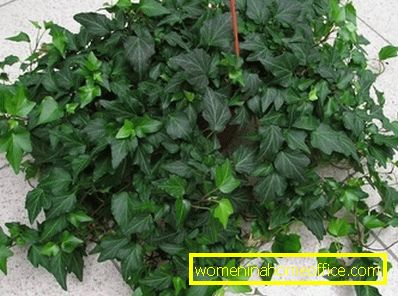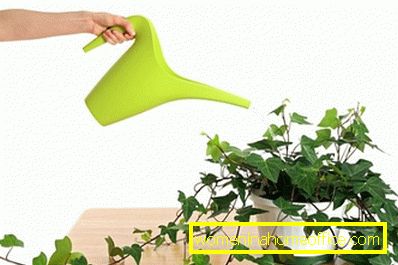Ivy flower
Curly green plants give special comfort to the dwelling, so people have long sought to decorate the house with such gifts of nature. Room ivy, requiring minimal care at home, is suitable for these purposes as well as possible. After all, he is not just cute, but does not require much attention to himself - a valuable quality for the modern rhythm of life!
Unrivaled Elegance

If it is possible to choose an association for a flower, then indoor ivy is elegance. The subtropical guest — the header — appeared in our latitudes long ago and quickly became one of the most beloved inhabitants of the window sills, even among experienced gardeners. This is due to the stunning simplicity of ivy. It is enough to say that he is happy to master the poorly lit spaces of rooms, as he grows in the wild in the shade of trees.
Due to the fact that the heder clings to any surface with roots, it is possible to decorate the interior with a plant: arches, columns or a balcony. It is only necessary to correctly expose the support - a bamboo or plastic stick. Also to the advantages of the flower include:
- resistance to temperature and drafts;
- undemanding to watering;
- possibility of propagation by cuttings at any time of the year.
Types of heders

Up to 400 species of indoor ivy are known in indoor floriculture. The photo shows how they are not similar. The most popular is 3 varieties.
- Hedera ordinary. On the dark green leaves of this plant, a grid of white veins is noticeable. This view is convenient because the thin roots can catch on any unevenness, even if it has a smooth texture. Common ivy is the collective name of such varieties as "Annette" with glossy bright leaves, "Chicago" - with brightly colored small ones, "Small diamond", the veinlets on the leaves of which are painted in cream color.

- Heder Canary. This type of ivy is completely unsuited to cling to the roots, so it definitely needs help. In gratitude for the care, he will please you with large leaves of variegated color.

- Fatshedera "Liza" is the result of experimental crosses of Japanese fatsia and ordinary ivy. Adult plant can stretch up to 5 meters.

Ivy care
Like any other plant, the header requires proper care of yourself. Consider the features of growing indoor ivy.
Lighting and accommodation

As already noted, ivy perfectly tolerates some shading, but still it is not necessary to deprive it of sunlight, especially if you got a variety with cream veins. So the window sill in a room without direct sunlight is a great place for a new pet. But in the heat of ivy with pleasure will move to the balcony.
Temperature
Hedera can comfortably develop at temperatures from +18 to +20 degrees Celsius. But in the cold season, this bar decreases by 6-10 values. In any case, it is necessary to monitor the average temperature and not to choose the right place in case the conditions are not quite acceptable.
Watering

Room ivy does not like excessive watering. In the summer, a plant needs 2 times of moisture per week. But in the winter, this procedure should be reduced to 1 time per week or two. It is imperative to check that the water does not stagnate in the drainage, otherwise the plant may die.
With pleasure Hedera takes and spraying - in the summer. It should be soft water at room temperature. But in winter the plant is better not to "bathe", and once a month to wipe the leaves with a cloth moistened with water or special polishes for plants.
Transfer
Heder's habitat should be changed once a year in spring. But if the plant develops quickly due to good care and the roots begin to entangle drainage, then planting ivy in new pots is possible and 2 times before summer and late autumn. It is important to choose the right capacity: it should be wide, not deep.
If the ivy is already "old", then we can restrict ourselves to updating the upper layer of soil. Expanded clay is used as a desiccant; it is laid in a layer of at least 2-3 cm. The opening for outflowing excess water should not be too large so that the roots do not germinate outside, but also not small so that water does not stand.
As for the mixture directly for the "living space" of a flower, then take leafy ground, soddy soil and sand. The proportion of these components is 2: 2: 1.
Breeding

As mentioned above, ivy breeds very easily. To do this, you can use:
- cuttings that root in the soil;
- Shoots, giving roots in water or soil;
- cuttings - escapes, fortified in the ground.
When bunches of small roots appear on the shoots, the plant can be planted in a separate pot.
Pests and diseases
Improper care may cause the header to wither. To prevent this, you need to carefully monitor the condition of the flower and avoid:
- excessive watering - otherwise the leaves will turn yellow;
- light deficiency causes leaf fading;
- too dry indoor air - this is fraught with darkening of the tips of the leaves;
- lack of fertilizer or stagnant soil - slow growth will result.
Like other plants, ivy is subject to attacks by some pests, for example, scale insects, aphids, spider mites. Fight them with standard measures.
Proven Facts and Superstitions
Heder is not recommended to start in homes where there is a small child. This is due to the fact that its leaves contain poison, which depresses the respiratory system. If this substance gets inside, then there may be difficulty breathing, convulsions.
However, cheder is valued in our homes - not only for simplicity, but also for symbolism. It is believed that this plant improves the energy of the room, helps create an atmosphere of goodness and love.
Even inexperienced gardeners can take care of indoor ivy at home. This plant is an excellent interior decoration, bringing a special atmosphere of freshness. But the most important thing is that heder does not require special care. Such powerful arguments are key for many of those who decide to start a green pet home.